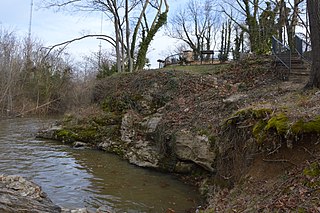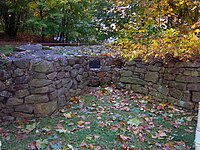
Quincy is a city in Norfolk County, Massachusetts, United States. It is the largest city in the county. Quincy is part of the Greater Boston area as one of Boston's immediate southern suburbs. Its population in 2020 was 101,636, making it the seventh-largest city in the state. Known as the "City of Presidents", Quincy is the birthplace of two U.S. presidents—John Adams and his son John Quincy Adams—as well as John Hancock, the first signer of the Declaration of Independence and the first and third governor of Massachusetts.

Bog iron is a form of impure iron deposit that develops in bogs or swamps by the chemical or biochemical oxidation of iron carried in solution. In general, bog ores consist primarily of iron oxyhydroxides, commonly goethite.

The North Shore is a region in the U.S. state of Massachusetts, loosely defined as the sea coast between Boston and New Hampshire. Its counterpart is the South Shore region extending south and east of Boston.

John Winthrop the Younger FRS was an English politician and scientist. An early governor of the Connecticut Colony, he played a large role in the unification of the colony's settlements into a singular colony and obtaining a royal charter for the colony.

An ironworks or iron works is an industrial plant where iron is smelted and where heavy iron and steel products are made. The term is both singular and plural, i.e. the singular of ironworks is ironworks.

Saugus Iron Works National Historic Site is a National Historic Site about 10 miles northeast of Downtown Boston in Saugus, Massachusetts. It is the site of the first integrated ironworks in North America, founded by John Winthrop the Younger and in operation between 1646 and approximately 1670. It includes the reconstructed blast furnace, forge, rolling mill, shear, slitter and a quarter-ton trip hammer.

The Iron Act, also called the Importation, etc. Act 1749, was an Act of the Parliament of Great Britain, which was one of the legislative measures introduced within the system of Trade and Navigation Acts. The Act sought to increase the importation of pig and bar iron from its American colonies and to prevent the building of iron-related production facilities within these colonies, particularly in North America where these raw materials were identified. The dual purpose of the Act was to increase manufacturing capacity within Great Britain itself, and to limit potential competition from the colonies possessing the raw materials.

Falling Creek Ironworks was the first iron production facility in North America. It was established by the Virginia Company of London in Henrico Cittie (sic) on Falling Creek near its confluence with the James River. It was short-lived due to an attack by Native Americans in 1622.

Cornwall Iron Furnace is a designated National Historic Landmark that is administered by the Pennsylvania Historical and Museum Commission in Cornwall, Lebanon County, Pennsylvania in the United States. The furnace was a leading Pennsylvania iron producer from 1742 until it was shut down in 1883. The furnaces, support buildings and surrounding community have been preserved as a historical site and museum, providing a glimpse into Lebanon County's industrial past. The site is the only intact charcoal-burning iron blast furnace in its original plantation in the Western Hemisphere. Established by Peter Grubb in 1742, Cornwall Furnace was operated during the American Revolution by his sons Curtis and Peter Jr. who were major arms providers to George Washington. Robert Coleman acquired Cornwall Furnace after the Revolution and became Pennsylvania's first millionaire. Ownership of the furnace and its surroundings was transferred to the Commonwealth of Pennsylvania in 1932.

Principio Furnace and village is in Cecil County, Maryland, 4 miles (6.4 km) northeast of Havre de Grace.

The Old Colony Iron Works-Nemasket Mills Complex is a historic industrial site located on Old Colony Avenue in the East Taunton section of Taunton, Massachusetts, United States, adjacent to the Taunton River at the Raynham town line. The site was first occupied by the Old Colony Iron Company, which had originally been established in the 1820s as Horatio Leonard & Company. The western part of the complex was sold to Nemasket Mills in 1889. The eastern part was acquired by the Standard Oil Cloth Company. The site was added to the National Register of Historic Places in 1984.

Thomas Baylies was a Quaker ironmaster first in England, then in Massachusetts.

Furnace Brook Parkway is a historic parkway in Quincy, Massachusetts. Part of the Metropolitan Park System of Greater Boston, it serves as a connector between the Blue Hills Reservation and Quincy Shore Reservation at Quincy Bay. First conceived in the late nineteenth century, the state parkway is owned and maintained by the Massachusetts Department of Conservation and Recreation (DCR) and travels through land formerly owned by the families of John Adams and John Quincy Adams, passing several historic sites. It ends in the Merrymount neighborhood, where Quincy was first settled by Europeans in 1625 by Captain Richard Wollaston. The road was started in 1904, completed in 1916 and added to the National Register of Historic Places (NRHP) in 2004.
Tobias Saunders was a Deputy to the Rhode Island General Assembly, a Conservator of the Peace and a founding settler of Westerly, Rhode Island.

The Taunton Iron Works was located on the banks of the Forge River in what is now Raynham, Massachusetts. It was the first iron works established in Plymouth Colony, and only the third in New England. Much more successful than earlier works at Saugus, and Braintree, it operated for a remarkable period of two hundred and twenty years, from 1656 to 1876.
Robert Child (1613–1654) was an English physician, agriculturalist and alchemist. A recent view is that his approach to agriculture belongs to the early ideas on political economy.
Richard Leader (1609–1661) was an English businessman who was the first manager of the Saugus Iron Works, the first integrated ironworks in North America. He later engaged in business in Maine and Barbados.
Roland Wells Robbins (1908–1987) was an American archaeologist, author, and historian who is known for discovering the site of Henry David Thoreau's house at Walden Pond. His other discoveries include the Saugus Iron Works and the John and Priscilla Alden Family Sites.
Joseph Jenckes Jr., also spelled Jencks and Jenks, was the founder of Pawtucket, Rhode Island, where he erected a forge in 1671.
Joseph Jenckes Sr., also spelled Jencks and Jenks, was a bladesmith, blacksmith, mechanic, and inventor who was instrumental in establishing the Saugus Iron Works in Massachusetts Bay Colony where he was granted the first machine patent in North America.



















